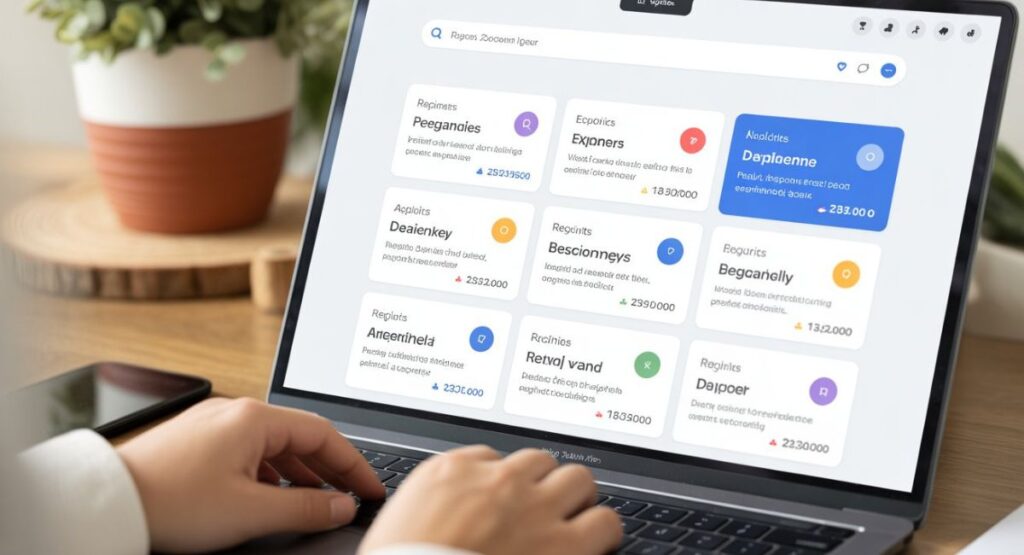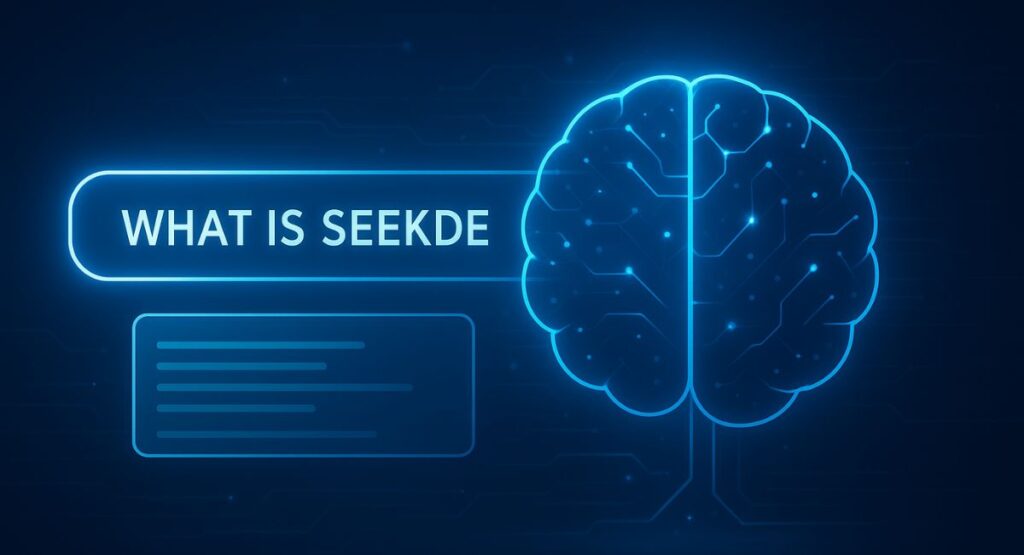Imagine this: you’re sitting at your desk with a cup of coffee bubbling on the table, waiting to study “how renewable energy affects local economies.” You enter the phrase into Google and are suddenly able to open a plethora of tabs: technical reports, news stories, and some blog posts, all of which are overlapping, conflicting or not complete. You’re confused, lost and unsure of which one is reliable.
Imagine you have a search assistant that does more than just provide the list of websites, but also guides you through the topic as it explains how ideas are connected and adjusts to the way you want to learn. This is what you can expect from Seekde.
Within this post, you’ll find:
- What exactly is Seekde (and the reasons it’s different from the traditional search engines)
- Its three pillars of strength include the advanced use of search technology, adaptive learning and knowledge mapping
- Use cases for educators, students professionals, as well as lifelong learners
- A step-by-step tutorial on how to use Seekde (in the concept)
- How can you adopt the Seekde approach to your research practices
- Best practices and challenges
Let’s get started.
Disclaimer: This content is for informational purposes only. Please do your own research and consult a professional before making any major decisions.
Seekde: From Search to Ecosystem
In essence, Seekde is a next-generation search and discovery platform. But, describing it as”a “search engine” undersells it. Instead imagine it as an online ecosystem for knowledge that is built around three interconnected elements:
- Advanced Search Intelligence – understands the context and not just the keywords
- Adaptive Learning evolves as your behaviour
- Knowledge Mapping shows how data, ideas, and concepts connect
Together, these capabilities combined, these features make Seekde more than just a tool. It’s an integral part of exploration.
Why Traditional Search Isn’t Enough
Traditional search engines excel in their ability to index the web. However, their results can create a mess, numerous links that are mixed in quality, with there is no order. It is essential to read, cross-check and put together the puzzle by yourself.
Contrarily, Seekde aims to:
- Get insights from a variety of reliable sources
- Remove noise and prioritizing credibility
- Visualize how ideas connect via graphs or maps
- Questions to follow-up on the guide so your interest doesn’t diminish.
In other words, Seekde doesn’t only give you a starting point; it also helps you gain knowledge.
The Pillars of Seekde
Below, each of the core components is explained using examples and links to provide more understanding.
Advanced Search Intelligence
Contrary to the simple matching of keywords, Seekde uses semantic search and natural processing of language (NLP) to understand your intention. It considers context, synonyms, and domain relevance. For instance, if you want to know “effects of microplastics in marine life,” Seekde acknowledges the fact that “effects” could mean biological harm, balance in the ecosystem or the impact of a policy.
Furthermore, Seekde can present rich media results – charts, summaries, definitions, and more–inline, rather than plain hyperlinks.
Adaptive Learning
One of the strengths of Seekde is that it can learn from the users. The more you use it, clicking links exploring nodes, re-visiting topics, the better it is in providing the appropriate quality, style, and the right speed.
This idea is similar to adaptive learning systems that are widely utilized in the fields of education and training. These platforms can tailor learning pathways according to the performance of learners and their interaction. Montclair State University+1 For instance platforms such as Smart Sparrow adjust content in real time to suit the needs of each individual learner. Wikipedia In the same manner, Seekde would fine-tune your experience, leading to greater efficiency and more satisfaction.
Knowledge Mapping & Visualization
One of the best features of Seekde is the use of knowledge maps. These are graphs with visuals that illustrate how topics and subtopics relate to each and each.
Knowledge maps are a tool that shows where knowledge is located and how it moves and the gaps. EU CAP Network+2EdrawMind+2 By displaying connections, it allows users to understand how they fit into the “big picture” rather than isolated locations.
In reality in the real world, if you search for “climate migration,” Seekde could show nodes that are linked to rising sea levels, economic impacts policies, and patterns of humanitarian migration. If the user clicks “policy responses,” the map will expand to include specific agreements, laws, and regional cases. This interactive view will help you understand the whole of a given area.
Why Seekde Matters: Use Cases & Impact
Let’s look at how various groups stand to benefit from Seekde.
For Students & Curious Learners
Are you still awestruck by the chaotic tabs? transforms the confusion into clearness.
- It covers the most important subjects and expands outward
- It provides definitions, subtopics as well as case studies in one glance
- It helps you move effortlessly between application and theory
For instance, a college student studying “urban farming in arid climates” could see nodes like water harvesting, soil technology community models and climate developments. When you click on one, the details are expanded without losing the context.
For Teachers & Course Designers
Teachers often take hours to put together the right set of materials. With Seekde:
- It is possible to create your own learning paths (guided sequences of learning through knowledge nodes)
- You can track the students’ explorations and see the places they fall.
- Maps can be integrated into assignments, lectures or even class discussions
In essence, Seekde becomes a co-designer within your course.
For Professionals & Researchers

In complex fields–business, medicine, engineering–information is fragmented, siloed, and technical. Seekde helps by:
- The information is gleaned from academic publications report from industry, academic papers, and other news
- Patterns or hidden links that you may not have noticed
- As an engine to discover deep dives
A market researcher studying “neuro-marketing in e-commerce” could discover connections to the behavior of consumers and the brain sciences, data ethics and regulation of advertising, all through one map.
For Organizations & Workflows
Some visionaries see Seekde evolving into an operational backbone for organizations–linking workflows, analytics, and knowledge in one unified interface.
Instead of navigating between Slack and projects tools, CRM and research documents A Seekde-based environment can allow you to view all of the information in one location, which reduces the need to switch between different contexts. This improves communication across teams and helps save cognitive energy.
How to Use Seekde (Step-by-Step Conceptual Guide)
Below is an example workflow that can be illustrated the use of Seekde as a tool in the real world:
| Step | Your Action | Seekde’s Response |
| 1 | Type a question (e.g. “causes and mitigation of desertification”) | Parses intent, provides a summary and the root knowledge node |
| 2 | Click on the connected node (e.g. “soil erosion”) | Map expands to define definitions Key studies, regional examples |
| 3 | Follow-up questions are suggested (e.g. “role of reforestation”) | Shows deeper content, visual comparisons, citations |
| 4 | Use “Suggested Paths” | Seekde offers a learning sequence starting with beginner, moving to intermediate and finally advanced |
| 5 | Mark, annotate or export the map, or export the | Save your customized map for future use, or you can use it to share with others. |
| 6 | Subtopics will be discussed in the future. | Seekde is able to recall your interest, and then refines future ideas |
What Happens in the Mind of a Learner
Take Amina, a university student who is working on an capstone project on green energy use in small towns
- She typed “renewable energy adoption”
- Seeks discovers nodes similar to solar policy grid infrastructure, community financing and public perception
- Clicks “community financing” and learns about cooperative solar models and municipal bonds
- She saves sources and then exports a mini-map for her presentation
- Then, she comes back, and Seekde suggests she look into microgrid case research
With the help of Seekde, Amina gains a solid structure, isn’t lost in the search process, and discovers connections she could be unable to see.
Adopting the Seekde Mindset: How to Think Like a Knowledge Explorer
Even even Seekde isn’t widely used in the moment, its philosophy may influence how you think about information. Here are some principles to follow:
- Find a connection, not only answers
Do not stop at one article. Follow hyperlinks and consider the implications. - Question the map
If you are unsure of a relationship or aren’t working, consider alternative routes. - Iterative curiosity
Begin broad start, then narrow, and finally expand outward again. It’s like a cycle. - Always confirm
Although Seekde is a noise filter, make sure you ensure that your sources are checked. - Note and share
Create your own personal maps over time and share these with friends.
In absorbing these practices You will become less dependent on any device and become an expert in your field.
Challenges & Important Considerations
An application as powerful as Seekde will have to deal with the real challenges. Here are a few issues and guidelines:
- Transparency and credibility of the source: The platform should clearly demonstrate the source of its information, including citations and trust levels to ensure that users can evaluate the reliability.
- Risk of over-dependence: Don’t believe that the map is reliable, but critical thinking is still necessary.
- Data ethics and privacy of users Data collected from users should be under the control of the user, and the system should allow the anonymization or deletion of personal information.
- Complex implementation: Creating interactive maps that can be updated in real time, adaptive and fluid UX is a major technical problem.
- “Scope creep”: Any system that is trying to accomplish “everything” risks becoming too wide and losing focus in certain domains.
Be mindful when using the tool. It is meant to support your thinking, not take it away.
Semantic Keywords & SEO Relevance
To ensure semantic SEO is aligned This article has incorporated relevant terms, such as:
- Knowledge mapping
- adaptive learning platforms
- search intelligence
- Digital learning ecosystem
- semantic search
- contextual understanding
- Discovery engine
- Knowledge graph
They help align the article with similar search terms and increase their thematic coherence.
Final Thoughts & Next Steps
The world is full of information overflow. In the absence of structure, information overload turns into noise. Seekde is a positive solution to not only find information, but also managing it. Through the combination of sophisticated search technology, adaptive intelligence along with knowledge mapping Seekde provides a revolutionary paradigm shift from search to discovery.
No matter if you’re a scholar, researcher, educator or professional, taking on the Seekde approach can be beneficial:
- Learn more deliberately
- Connectivity is better than isolated facts
- Trust your understanding
- Be a confident digital explorer
Want to learn more? Visit our blog for more helpful and informative articles.
FAQs
What is Seekde?
Seekde is an AI-powered search platform that delivers direct answers instead of just links.
How is Seekde different from Google?
Google lists pages, while Seekde synthesizes information into clear, connected insights.
Who can use Seekde?
Students, researchers, professionals, and everyday users can all benefit from smarter results.
Does Seekde use AI?
Yes, AI and Machine Learning help Seekde understand context and personalize results.

I’m SEO expert and content writer at SEO Guest Pro.
I help websites rank higher, get more traffic, and grow fast using smart SEO and engaging content.
Let’s grow together!

